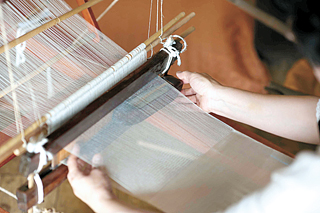Korean craftworks on display at MMCA

1. “Mosi Clothes” by Park Mi-ok 2. “Teapot” by Ko Bo-hyung 3. “Banjja Bell” by Lee Bong-ju 4. “Reincarnation” by Oh Hwa-jin 5. “Pure Water-purifying Pot,” front row, by Pai Yon-shik and “Teatools,” back row, by Kang Ki-ho. The “Craft Narrative: The Place, Process, Perspective” exhibition at National Museum of Modern and Contemporary Art (MMCA) Seoul emphasizes the thought and the sweat of craftsmen that go into these final products. [NATIONAL MUSEUM OF MODERN AND CONTEMPORARY ART]
The National Museum of Modern and Contemporary Art (MMCA) Seoul is holding its first exhibition dedicated to Korean craftworks.
The organizers of the exhibition hope to shed light on who the craftsmen are; their philosophies and attitudes toward their work and life; how they work with their materials; and all the sweat that goes into the process.
The exhibition, appropriately titled “Craft Narrative: The Place, Process, Perspective,” is divided into three sections: first to craft masters working with metal; second to artists whose materials are earth; and last to craft masters working with textiles.

Mosi weaver Park Mi-ok learned her techique from her mother. The looms she used are also on display at the exhibition. [NATIONAL MUSEUM OF MODERN AND CONTEMPORARY ART]
In the first section, “Knocking Time,” visitors can see the works of Lee Bong-ju and Koh Bo-hyung who work with metal. Lee makes bangjja yugi (a type of brassware) and his traditional technique is designated Korea’s Intangible Cultural Heritage No. 77.
Bangjja has an alloy ratio of 78 percent copper and 22 percent tin and is made through a hammering process. Bells made of bangjja, known for clear sound and resonance, are often used in Korean religious institutes. The section actually opens with Lee’s “Bangjja Bell.” Visitors can actually play them at certain hours.
Koh’s works, particularly tableware and kitchenware, look extremely modern, as seen in his piece “Taepot.” He also engages in processes like hammering and bending but he says he particularly likes playing with curves and straight lines.
The pieces of potters Pai Yon-shik and Kang Ki-ho, in fact, look like opposites. While Pai’s pieces look rough and raw, Kang’s pieces are clean-cut and minimalistic.
Pai’s signature bluish earthenware is the result of many years of hard, physical work. He matures soil for three years; makes them into pottery and decorates the surface, usually with his thumbnail, and bakes them in a kiln at over 1,300 degrees Celsius (2,372 degrees Fahrenheit) for five days.
“I didn’t really think that my rather unorthodox techniques and pottery would get recognized in my lifetime,” he said at a press event on Wednesday. “For every craftsman, it takes a lot of work and conviction just maintaining the workshop. I hope that through the exhibition, more people realize that.”
Kang is actually the youngest of the six participating craftsmen, at 36 years old. The German-based artist resorts to the “coiling” technique in which clay is made into long round coils and piled up.
In the last section, the pieces of mosi (thin and delicate ramie) weaver Park Mi-ok and artist Oh Hwa-jin are displayed. “Being soft and flexible, textile gives much freedom to artists,” curator Do Hwa-jin said. “Historically, it’s also been the field where a woman’s life, emotions and aesthetics are embedded.”
Park is the only master artist of the famous Hansan mosi, or ramie from the Hansan region. A great quality mosi with Park’s signature fine weaving is cool in the summer and warm in the winter.
Where as Park is more of a technician, Oh is more spontaneous and intuitive, taking full advantage of the freedom and flexibility textiles as a material gives the artist.
BY KIM HYUNG-EUN [hkim@joongang.co.kr]
*The exhibition runs until Jan. 30 of next year. Admission is 4,000 won ($3.60). For more information, call 02-3701-9500 or visit the museum’s website, http://www.mmca.go.kr.










with the Korea JoongAng Daily
To write comments, please log in to one of the accounts.
Standards Board Policy (0/250자)